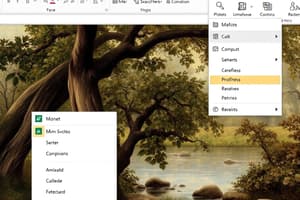Podcast
Questions and Answers
What triggers the Unfolded Protein Response (UPR)?
What triggers the Unfolded Protein Response (UPR)?
- Slow folding of proteins (correct)
- Excessive protein degradation
- Increased vesicle formation
- High levels of protein synthesis
What sequence is necessary for N-linked glycosylation to occur?
What sequence is necessary for N-linked glycosylation to occur?
- Asn-X-Ser/Thr (correct)
- X-Asn-Ser
- Ser-X-Thr
- Thr-X-Asn
Which of the following proteins will NOT exit the ER?
Which of the following proteins will NOT exit the ER?
- Properly folded proteins
- Correctly assembled multimeric proteins
- Proteins with an ER retention signal (KDEL) (correct)
- Misfolded proteins retained by chaperones (correct)
What is the main function of chaperones in the ER?
What is the main function of chaperones in the ER?
Which part of the Golgi network faces the plasma membrane?
Which part of the Golgi network faces the plasma membrane?
What is the consequence of the Unfolded Protein Response (UPR) being triggered?
What is the consequence of the Unfolded Protein Response (UPR) being triggered?
True or False: Vesicles from the ER fuse with the trans Golgi network.
True or False: Vesicles from the ER fuse with the trans Golgi network.
What happens to vesicles produced by the cis Golgi network?
What happens to vesicles produced by the cis Golgi network?
What is a characteristic feature of proteins moving through the Golgi apparatus?
What is a characteristic feature of proteins moving through the Golgi apparatus?
What is true about constitutive secretion?
What is true about constitutive secretion?
In which process do proteins aggregate and are stored until a signal is received?
In which process do proteins aggregate and are stored until a signal is received?
What initiates the release of insulin from pancreatic β cells?
What initiates the release of insulin from pancreatic β cells?
Which statement about exocytosis is correct?
Which statement about exocytosis is correct?
The process of exocytosis is primarily responsible for moving which substances to the plasma membrane?
The process of exocytosis is primarily responsible for moving which substances to the plasma membrane?
What is the role of SNARE proteins in the secretion process?
What is the role of SNARE proteins in the secretion process?
What is the primary function of lysosomes in a cell?
What is the primary function of lysosomes in a cell?
What characterizes transcytosis in cellular processes?
What characterizes transcytosis in cellular processes?
In receptor-mediated endocytosis, what determines the fate of receptor proteins after endocytosis?
In receptor-mediated endocytosis, what determines the fate of receptor proteins after endocytosis?
Which term describes the process of engulfing large particles by immune cells?
Which term describes the process of engulfing large particles by immune cells?
What is the visible result of autophagy within a cell?
What is the visible result of autophagy within a cell?
What is the primary structural feature of a clathrin subunit?
What is the primary structural feature of a clathrin subunit?
Which protein is responsible for pinching off the clathrin-coated vesicle?
Which protein is responsible for pinching off the clathrin-coated vesicle?
What role do adaptins play in clathrin-coated vesicle formation?
What role do adaptins play in clathrin-coated vesicle formation?
What is the function of Kinesins in vesicle transport?
What is the function of Kinesins in vesicle transport?
Which type of coated vesicle is involved in anterograde transport from the ER to the Golgi apparatus?
Which type of coated vesicle is involved in anterograde transport from the ER to the Golgi apparatus?
What occurs during the initial stages of vesicle formation?
What occurs during the initial stages of vesicle formation?
What defines the function of Dynein in vesicle transport?
What defines the function of Dynein in vesicle transport?
What type of structure do clathrin molecules form during vesicle budding?
What type of structure do clathrin molecules form during vesicle budding?
What is the primary role of the Golgi apparatus in the vesicular transport pathway following cargo arrival from the ER?
What is the primary role of the Golgi apparatus in the vesicular transport pathway following cargo arrival from the ER?
Which process involves the uptake of fluids and molecules in small vesicles?
Which process involves the uptake of fluids and molecules in small vesicles?
What is characterized by the uptake of particles into large vesicles called phagosomes?
What is characterized by the uptake of particles into large vesicles called phagosomes?
Which type of endocytosis is selective for specific macromolecules?
Which type of endocytosis is selective for specific macromolecules?
What happens to vesicles that fuse with lysosomes after endocytosis?
What happens to vesicles that fuse with lysosomes after endocytosis?
Which of the following is NOT a type of endocytosis?
Which of the following is NOT a type of endocytosis?
What role do endosomes play in exocytosis and endocytosis?
What role do endosomes play in exocytosis and endocytosis?
During which process can viruses enter cells, often resulting in the virus’s genome being released?
During which process can viruses enter cells, often resulting in the virus’s genome being released?
Flashcards are hidden until you start studying
Study Notes
N-linked Glycosylation
- The amino acid sequence Asn-X-Ser/Thr on a protein is required for N-linked glycosylation.
- Each oligosaccharide chain is transferred as a whole unit to the Asn from a lipid called dolichol.
- Oligosaccharides are further modified in the ER and Golgi apparatus.
ER Exit
- The exit from the ER is controlled to ensure protein quality.
- Proteins do not leave the ER if they:
- have an ER retention signal (KDEL sequence at the C-terminus)
- are misfolded
- retained by chaperones
- are incorrectly assembled into multimeric proteins
- retained by chaperones
Unfolded Protein Response (UPR)
- The UPR is triggered if protein folding takes too long in the ER.
- The UPR increases ER and folding machinery (chaperones) to help fold proteins quicker.
- The UPR slows down ER protein synthesis to give folding machinery time to catch up.
Golgi Network
cisGolgi network: faces the ER- buds vesicles that return to the ER or continue through the Golgi.
transGolgi network: faces the plasma membrane- buds vesicles headed to the plasma membrane or other compartments.
- Vesicles from the ER do not fuse with the
transGolgi network.
Golgi Modifications
- Different stacks of the Golgi contain different enzymes, allowing for progressive processing of proteins as they move from the
cisto thetransface. - Proteins exiting the
transGolgi network are sorted based on their next destination.
Exocytosis
Constitutive secretion:- the default pathway, does not require a specific signal sequence
- continuous process
Regulated secretion:- occurs in some cells
- proteins aggregate and are stored in secretory vesicles until a signal is received.
- An example of regulated secretion:
- Increased glucose levels in the blood trigger the release of insulin from pancreatic β cells.
- This process involves glucose metabolism, ATP-sensitive K+ channels, voltage-gated Ca2+ channels, and SNARE proteins.
- In this process, increased ATP levels activate K+ channels and do not hyperpolarize the membrane.
Endocytosis
Endocytosisis the uptake of material into a cell by membrane invagination and internalization of the resulting vesicle.Phagocytosis:- uptake of particles into large vesicles (phagosomes)
- occurs in phagocytic cells (dendritic cells, macrophages, and neutrophils)
- Phagosomes fuse with lysosomes.
Pinocytosis:- uptake of fluids and molecules in small vesicles.
- Occurs via clathrin-coated pits and vesicles.
- Balanced with exocytosis.
- Vesicles fuse with endosomes.
- Pinocytosis is generally a non-specific process
Receptor-mediated endocytosis:- selective endocytosis of specific macromolecules.
- LDL, low-density lipoproteins (cholesterol + proteins)
Viruses and Endocytosis
- Viruses can enter cells through receptor-mediated endocytosis.
- These vesicles can fuse with lysosomes leading to the release of the viral genome into the cytoplasm and subsequent replication.
Endosomes
- Endosomes are sorting compartments.
- Receptors can be recycled to the same plasma membrane, directed to lysosomes for degradation, or transcytosed to a new plasma membrane area.
Clathrin Coats
- Clathrin-coated vesicles are a major component of the cell's transport system.
- The primary protein in clathrin-coated vesicles is clathrin.
- Each clathrin subunit is made of three large and three small polypeptide chains that form a three-legged structure called a triskelion.
- Triskelions readily assemble into polyhedral cages.
Vesicle Formation
- Clathrin-coated vesicle formation is driven by the assembly of a protein coat.
- Cargo receptors recognize transport signals on cargo molecules and bind to them.
- Adaptins connect coat proteins to cargo receptors.
- Clathrin proteins form basket-like cages that shape membranes into vesicles.
- Dynamin, a GTP-binding protein, pinches off the vesicle.
- The clathrin coat disassembles after the vesicle is pinched off.
Coated Vesicles
- COP (coat protein) coated vesicles mediate membrane transport.
COPIImediates anterograde transport from the ER to the Golgi.COPImediates retrograde transport from the Golgi to the ER.- Clathrin participates in endocytosis at the plasma membrane and transport between the Golgi and endosomes.
Vesicle Movement
Kinesinsmove cargo from the cell body towards the cell periphery (anterograde transport).Dyneinmoves cargo back toward the cell body (retrograde transport).
Vesicle Fusion
- Protein-protein interactions mediate the fusion of transport vesicles with appropriate membranes.
Receptor-mediated Endocytosis
- The fate of receptor proteins after endocytosis depends on the type of receptor.
Lysosomes
- Lysosomes are the sites of intracellular digestion.
- Lysosomes digest extracellular materials and old organelles.
- They are acidic due to the activity of an H+ pump.
- They contain transporters that export metabolites.
- Lysosomal membrane proteins are glycosylated for protection.
- The signal sequence for Lysosomal targeting is mannose-6-phosphate (M6P), recognized at the
transGolgi network.
Lysosomal Pathways
Autophagy: enclosure of an old organelle in a double membrane, creating an autophagosome.
Phagocytosis
- Phagocytosis is the uptake of large particles by certain cells, primarily immune cells like macrophages and neutrophils.
Studying That Suits You
Use AI to generate personalized quizzes and flashcards to suit your learning preferences.




